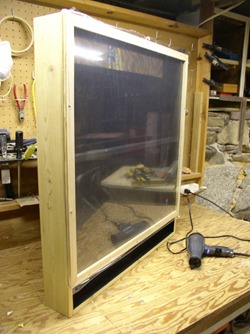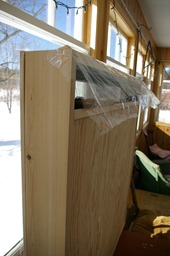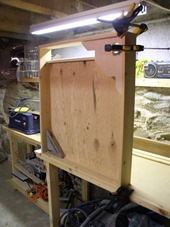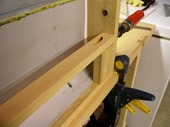 Most solar air heaters you’ll find are large wall-mounted units and the utility of a ‘portable’ unit is marginal at best. But I had a specific purpose in mind for this design.
Most solar air heaters you’ll find are large wall-mounted units and the utility of a ‘portable’ unit is marginal at best. But I had a specific purpose in mind for this design.
While I actually completed this project a long time ago I’m just getting around to posting this quick review of my design and it’s performance after having recently tested it again at a passive solar heating workshop I hosted at our our local makerspace.
Window shade / solar heater
There’s likely no real advantage to putting a solar heater in a window since it blocks the natural solar gain you’d get through the window. In my case my goal was to keep the sun off my laptop screen while still taking advantage of the passive solar gain from the morning winter sun.
I’d planned to hang it in front of the upper sash of a double hung window but I never did get around to installing it.
 Construction Details
Construction Details
The pictures pretty much tell the story and you can study these larger images to see the details. My prototype is about 30”wide x 30”high x 4”deep.
The air intake is at the bottom front – the idea being that it would catch the air leakage at the meeting rails between sashes. The full-width openings are 3”high.
- interior painted with matte black finish heat-resistant paint

- 1/4” plywood back
- sheet aluminum formed as a scoop
- 3/4” frames stapled at mitred corners and wrapped with typical window screen on both sides
- foil bubble wrap insulation
The rail across the centre where the two screens meet is there to force the airflow away from the ‘’glazing” which is actually plastic window insulating film attached to both sides of a 3/8” thick front frame.
I applied some closed cell foam insulation to the front edge of the unit and screwed the frame on after shrinking the layers of film with a blow dryer.



Performance
 My first test was in my uninsulated front porch. The room temperature taken just behind the heater was 10C (50F). The thermometer placed at the air output (without direct sunlight on it) registered 25C (72F) – that’s a 15C (22F) temperature rise in the 24” between the input and output openings.
My first test was in my uninsulated front porch. The room temperature taken just behind the heater was 10C (50F). The thermometer placed at the air output (without direct sunlight on it) registered 25C (72F) – that’s a 15C (22F) temperature rise in the 24” between the input and output openings.
I’ve only tested this solar air heater twice since building it and I was fairly pleased with the performance considering it’s small size and the fact that it relies entirely on thermosiphoning for airflow.
Useful experiment
You can see in the photo that there was enough  airflow to make the plastic film covering the upper opening to flip up to about a 30 degree angle. My second test, done a couple of weeks ago, (outdoors) gave similar results.
airflow to make the plastic film covering the upper opening to flip up to about a 30 degree angle. My second test, done a couple of weeks ago, (outdoors) gave similar results.
I probably won’t ever use this for it’s intended purpose – but it’s provided the proof of concept I need to pursue more refined designs in the future.
Related posts on this site:
Comparing Solar Air Heater Designs & Performance
Solar Heat: Free for the Taking
Earthships: Sustainable & Self-Sufficient Living
Home Solar: New Financing Options Making it Affordable
Superinsulated House Design
7 DIY Pop Can Solar Heaters
Add Flexibility to Plastic Window Kits




